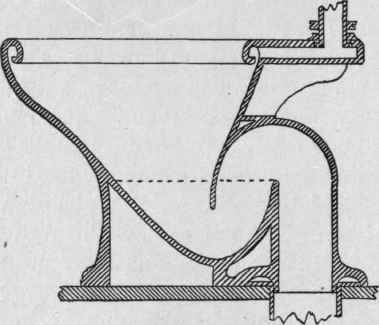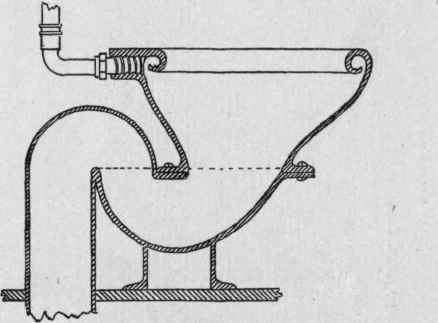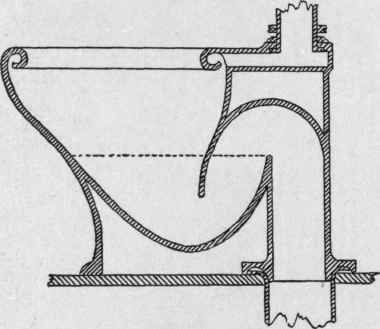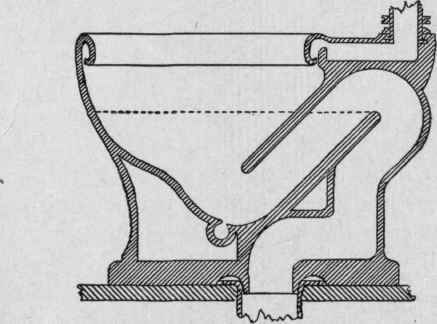Plumbing. Part 7
Description
This section is from the book "The Care Of A House", by T. M. Clark. Also available from Amazon: The Care Of A House.
Plumbing. Part 7
Among the modern closets there is nothing, perhaps, more satisfactory, considering its simplicity and freedom from repairs, than the short flushing-rim hopper, which can be had, including the trap, in a single piece of porcelain (Fig. 17), or with a porcelain basin, bolted or clamped to a lead or iron trap (Fig. 18). It is curious that the first water-closets made, after the invention of the trap, about 1840, rendered it practicable to have such an apparatus within the walls of a dwelling-house, were substantially the same as the modern hopper, the improvements consisting in the substitution of earthenware or porcelain, as a material, for the cast iron of the early hoppers, and the addition of the flushing-rim. In its present form, the short hopper presents the great advantage of having no moving or concealed parts, while the contents of the basin remain in plain sight until they are washed entirely out beyond the trap, never to return or give trouble, by a flush of water which, entering on all sides through the flushing-rim, and descending with considerable force, washes the sides of the basin. Unfortunately for the popularity of an excellent apparatus, the efficiency of this washing action of the flush is not all that could be desired. If the closet is used when the sides of the basin are dry, they will receive a stain which the force of the flushing-water is insufficient to remove; and such stains, although really harmless, are unpleasant in appearance. They can be avoided by a preliminary flushing of the basin, to wet the sides and prevent adhesion; but this is generally forgotten, so that short hoppers, in practice, need frequent scrubbing to keep them presentable.
Water-closets.
Short hoppers.

Fig. 17.

Fig. 18.
A modification of the short hopper has the bend of the trap raised, so as to hold a larger body of water in the basin, and in this way prevent the staining of the sides (Fig. 19); but a strong flush is needed to carry this increased volume of water over the additional height of the bend of the trap, without leaving floating material in the basin.
Wash-down closets.
To meet the two requirements, of keeping a large volume of water in the basin, and of having it entirely removed by the flush, the principle of the siphon is now extensively applied to closets. Every one knows that a bent tube, having one leg longer than the other, will draw all the water out of a tumbler into which the short leg is plunged, if the tube is once filled with water, by sucking at the long end or otherwise. In applying this principle to a water-closet, the trap and the waste-pipe beyond form the siphon, the basin forming a part of the short leg; and the problem to be solved is how to fill the bore of the pipe beyond the trap completely with water, so as to create a suction which will bring the siphon action into play, and draw over, by atmospheric pressure, all the contents of the short leg of the siphon, including the basin. In most closets, this result is accomplished by means of a "jet," which is seen as a small hole opening almost at the bottom of the basin on the side opposite the trap, and is supplied through a conduit formed in the earthenware of the basin, communicating with the flush ing-rim. When the closet is flushed, a part of the flushing-water rushes down this conduit and out of the jet, which is so formed as to throw the water in the direction of the axis of the trap. Partly by the additional quantity of water so supplied, but still more by the force with which it is projected (Fig. 20), enough liquid is thrown at once over the bend of the trap to fill the waste-pipe beyond, which is slightly contracted for the purpose; and, as soon as this pipe is completely filled, the atmospheric pressure on the surface of the water in the basin comes into action, and the whole is sucked over the bend of the trap into the waste-pipe. The air rushes after it, and again fills the pipe behind the descending column of water, leaving the apparatus ready for a repetition of the process; while, as the flushing-valve closes, enough more water trickles in to refill the basin to the normal depth.

Fig. 19.
Siphon-closets.

Fig. 20.
This is an excellent type of closet, and is deservedly popular, being clean and efficient, and having no moving parts to get out of order, and no concealed spaces in which filth can collect unseen. The most serious objection to it is that the jet-tube, being below the bottom of the basin, is not cleared of water by sponging out the trap, and unless special means are taken to remove the water, in case the house is to be left vacant in winter, it will freeze in the jet-tube, and destroy the closet. It is possible to remove the water in the jet-tube by means of a small sponge, tied to a wire, and inserted through the orifice of the jet after the basin has been sponged out; or by unscrewing the brass plug on the outside of the closet which some manufacturers provide for the purpose; but plumbers usually unscrew the bolts and couplings, and take the closet up, and reverse it, so as to let the water run out of the jet-tube. The closet is reset in its proper position either immediately, or when the house is again occupied in the spring; but there is always some uncertainty whether it will be reset with due care and skill, and a few minutes' time spent with a wire and a little sponge in getting the water out of the orifice of the jet, instead of taking up the closet, will often save the householder the unwelcome experience of finding the closet broken, through careless tightening of the bolts and couplings in resetting, or of suffering all summer from leakage of sewer-gas, owing to imperfect puttying of the joint around the flange of the closet when reset. In order to avoid the risk of these troubles, without spending time in the slow sponging out of the jet-tube, some plumbers simply throw a handful of salt into the basin, without even sponging this out. The salt dissolves in the water in the basin, and finds its way into that in the jet-tube; and, as a strong solution of salt does not freeze into a hard mass, but, if at all, only into a sort of icy mud, this will protect the closet against bursting by freezing. If the closet-basin is made of "vitreous china," a sort of porcelain much used, and very desirable for such purposes, the salt can be used with safety; but a strong solution of salt should not be allowed to stand in contact with ordinary earthenware, or to touch brass sockets, plugs, or other fittings.
Continue to:


